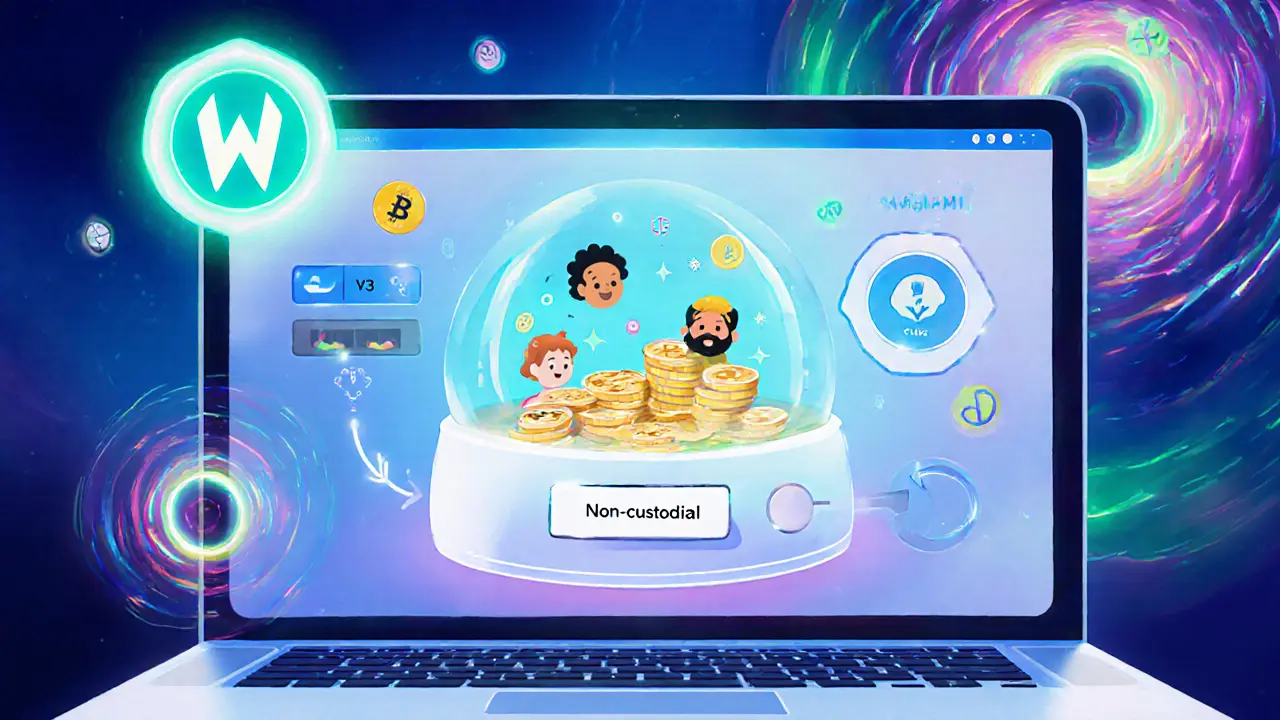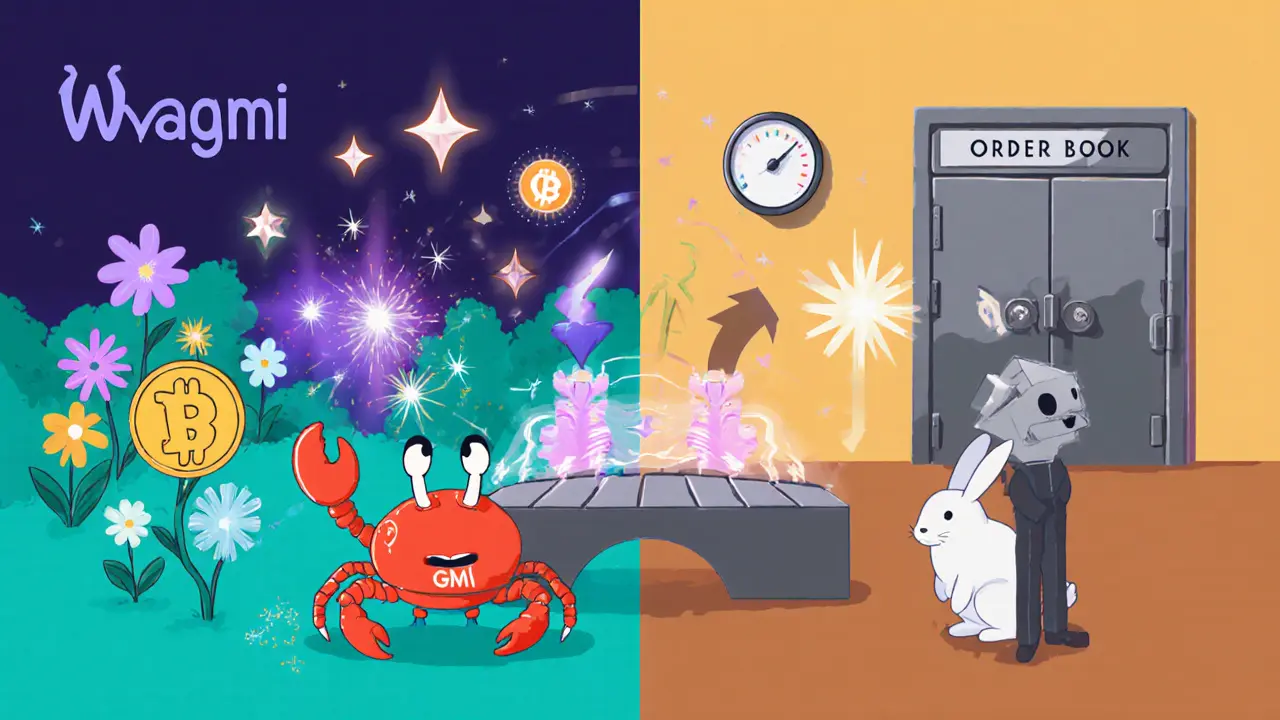
Wagmi (Sonic) Crypto Exchange Comparison Tool
Non-custodial - Your funds stay in your wallet
On-chain AMM - Uses Uniswap V3 pools
GMI Multiposition Concentrator - Reduces gas costs
Leverage - Built-in leveraged swaps via GMI
Fee Model - Pool swap fees + protocol fees
WAGMI Token: $0.0047
Custodial - Exchange holds your assets
Central Order Book - Matches orders off-chain
Margin Trading - Margin accounts with limits
Limit Orders - Available on most platforms
Fee Model - Spread + withdrawal fees
KYC Required - Identity verification needed
| Feature | Wagmi (DeFi) | Typical CEX |
|---|---|---|
| Custody | User-self-custody (non-custodial) | Custodial (exchange holds assets) |
| Order Matching | On-chain AMM pools | Central order book |
| Fee Model | Pool swap fees (0.05-0.30%) + protocol fees | Spread + withdrawal fees |
| KYC/AML | None required | Often mandatory |
| Leverage | Built-in leveraged swaps on V3 pools (via GMI) | Margin accounts with varying limits |
| Support Channels | Community Discord, GitHub, Twitter | Live chat, email, phone |
WAGMI Token Price: $0.0047
Market Status: Neutral (RSI 31.38)
Forecast: Bearish technicals, but potential for growth to $0.0069 by end of 2025
Utility: Governance, staking rewards, access to advanced features
Smart Contract Risks: Medium
Impermanent Loss: High (for LPs)
Leverage Risk: High (amplifies gains and losses)
Volatility: High (token and markets)
Support: Medium (community-driven)
Important Note
Wagmi is a DeFi protocol that runs on Ethereum. It differs fundamentally from traditional exchanges by offering non-custodial trading with integrated swapping, liquidity provision, and leveraged trading-all through your wallet. Be aware of the risks associated with DeFi protocols, including smart contract vulnerabilities and price volatility.
Wagmi crypto exchange review - you might be wondering whether Wagmi (sometimes called Sonic) is a typical centralized crypto exchange or something else. Below is a quick snapshot before we dive deeper:
- Wagmi is a DeFi protocol, not a traditional exchange.
- It offers swapping, liquidity provision, leverage on V3 pools, and a multiposition concentrator called GMI.
- The native token, WAGMI (WAGMI Token), trades around $0.0047 and provides governance rights.
- Originates from Popsicle Finance, inheriting many liquidity‑strategy tools.
- Roadmap includes multi‑chain roll‑out, limit orders, and expanded leverage features.
What Exactly Is Wagmi?
When you stumble upon the name Wagmi (a decentralized finance platform that bundles swapping, liquidity provision, and leveraged trading in one UI), the first question is: is it an exchange? The short answer: no. Wagmi operates as a DeFi (a blockchain‑based financial ecosystem that runs without a central authority) protocol. It lives on Ethereum, leverages Uniswap V3 liquidity pools, and lets users interact directly from their wallets.
How It Differs From a Traditional Crypto Exchange
Typical centralized exchanges (CEXs) hold your funds, match orders off‑chain, and charge a spread plus withdrawal fees. Wagmi skips the middleman. Here’s a side‑by‑side view:
| Feature | Wagmi (DeFi) | Typical CEX |
|---|---|---|
| Custody | User‑self‑custody (non‑custodial) | Custodial (exchange holds assets) |
| Order Matching | On‑chain AMM pools | Central order book |
| Fee Model | Pool swap fees (0.05‑0.30%) + protocol fees | Spread + withdrawal fees |
| KYC/AML | None required | Often mandatory |
| Leverage | Built‑in leveraged swaps on V3 pools (via GMI) | Margin accounts with varying limits |
| Support Channels | Community Discord, GitHub, Twitter | Live chat, email, phone |
Key Technical Building Blocks
The protocol’s edge comes from two innovations:
- GMI (a multiposition concentrator that aggregates several positions into a single, more efficient slot). GMI reduces gas costs and improves capital efficiency for liquidity providers.
- Leverage on Uniswap V3 pools. By borrowing against deposited assets, users can amplify exposure without leaving the AMM environment.
Both features aim to make DeFi trading as smooth as a centralized experience, while still preserving non‑custodial ownership.
The WAGMI Token: Utility and Governance
The WAGMI Token (the native utility and governance token of the Wagmi protocol) serves three main purposes:
- Governance: Holders vote on protocol upgrades, fee structures, and new feature roll‑outs.
- Staking & Rewards: Staking WAGMI can earn a share of protocol fees, similar to liquidity mining.
- Access: Certain advanced strategies (e.g., high‑leverage positions) may require a minimum token balance.
Current market data (October2025) shows WAGMI trading around $0.0047, with a 31‑day RSI of 31.38-neutral territory. Technical analysis leans bearish, with 31 out of 32 indicators flagging downside momentum. Forecasts vary: some models predict a rise to $0.0069 by the end of 2025, while others keep the token in the sub‑$0.004 range.

User Experience: UI, Fees, and Accessibility
Wagmi’s web interface is a single‑page dashboard that connects to MetaMask, WalletConnect, or other EVM‑compatible wallets. The UI mirrors popular DEXes: a swap box on the left, a liquidity provision screen on the right, and a toggle for leveraging positions.
- Swap fees: Typically 0.05%‑0.30% depending on the underlying pool, plus a small protocol fee (≈0.05%).
- Liquidity fees: Earn the pool’s fee tier; GMI helps concentrate capital, boosting returns.
- Leverage costs: A borrowing rate tied to the pool’s utilization, currently around 4‑6% APR.
Because there’s no KYC, onboarding is instant: connect your wallet and start swapping. However, the lack of customer support means you rely on community channels for troubleshooting. The Discord (≈2,000 members) is active, and the GitHub repo shows regular commits, indicating a healthy development cadence.
Roadmap & Future Outlook
The team’s roadmap (last updated June2025) highlights three pillars:
- Multi‑chain expansion: Deploying contracts on Arbitrum, Optimism, and potentially Polygon to lower gas costs.
- Advanced order types: Limit orders and stop‑loss mechanisms slated for Q42025.
- Enhanced leverage: Introducing up to 10x leverage on select V3 pools, plus risk‑management dashboards.
These upgrades signal that Wagmi aims to become a full‑service DeFi hub, narrowing the gap with CEXs while preserving decentralization.
Pros, Cons, and Who Should Use Wagmi
Pros
- Non‑custodial control-your keys, your assets.
- Integrated swapping, LPing, and leverage in one place.
- Low‑fee AMM pricing, especially with GMI’s capital efficiency.
- Active community and transparent development.
Cons
- No traditional order book or advanced charting tools.
- Limited token liquidity; WAGMI trades on few major DEXes.
- Support is community‑driven; no 24/7 help desk.
- Technical complexity-leverage and GMI require understanding of liquidity mechanics.
Best fit
- DeFi enthusiasts comfortable with wallet‑based trading.
- Traders looking for on‑chain leverage without surrendering custody.
- Liquidity providers who want to maximize returns via GMI.
Not ideal for beginners who prefer a simple UI, fiat on‑ramps, or dedicated support.
How to Get Started on Wagmi
- Install a Web3 wallet (MetaMask, Trust Wallet, etc.).
- Visit wagmi.com and click “Connect Wallet.”
- Deposit ETH or an ERC‑20 token to the swap box.
- Choose “Swap,” “Provide Liquidity,” or “Leverage” from the dashboard.
- If you plan to vote or stake, acquire WAGMI from a DEX like Uniswap.
Remember to test with a small amount first; DeFi transactions are irreversible.
Frequently Asked Questions
Is Wagmi a centralized exchange?
No. Wagmi is a decentralized finance protocol that runs on Ethereum. Users retain custody of their funds through self‑hosted wallets.
What does the WAGMI token do?
WAGMI provides governance voting rights, can be staked for a share of protocol fees, and grants access to certain advanced features like high‑leverage trading.
How does leverage work on Wagmi?
Leverage is offered directly on Uniswap V3 pools. Users borrow against their collateral, paying an APR that reflects pool utilization. The GMI engine aggregates positions to keep gas costs low.
Is there any KYC or account verification?
No. Since Wagmi is a non‑custodial protocol, you only need a compatible wallet. All on‑chain actions are pseudonymous.
What are the main risks when using Wagmi?
Risks include smart‑contract bugs, liquidity‑provider impermanent loss, and price volatility of the WAGMI token. Leveraged positions amplify both gains and losses, so only use them if you understand the mechanics.


Comments
Rampraveen Rani
Wagmi is not an exchange lol why is everyone confused? Its just Uniswap V3 with a fancy UI and leverage baked in. GMI is the real MVP.
Abby Gonzales Hoffman
I’ve been using Wagmi for 6 months now and honestly it’s the only DeFi platform that doesn’t make me feel like I’m coding in a terminal. The GMI concentrator saved me so much gas, I literally stopped trading on Uniswap altogether. If you’re LPing, you’re leaving money on the table without it.
Prabhleen Bhatti
As someone who came from traditional finance, the lack of KYC is both a blessing and a curse. I love the freedom but when I got frontrun on a leveraged swap, there was no support-just a Discord thread with 47 replies saying ‘read the docs’ 😅 Still, the tech is solid. The roadmap to multi-chain is huge-Arbitrum deployment will be a game changer for Indian traders like me who get wrecked by ETH gas.
Elizabeth Mitchell
I tried it once. Got confused by the leverage toggle. Ended up losing 0.02 ETH. Now I just use Coinbase. Not judging, just… not for me.
ashish ramani
The WAGMI token is overhyped. 0.0047 with a 31 RSI? That's not neutral, that's dead. No real utility beyond governance and even that's weak because only 12 wallets hold 80% of supply. Don't get sucked in by the name.
Richard Williams
To everyone saying it’s too complex: you don’t need to understand every layer to use it. Start small. Swap 0.1 ETH. Add liquidity with GMI. Watch how your returns improve. Then go for leverage. Baby steps. You got this.
Ashley Cecil
The post incorrectly states that Wagmi 'inherits many liquidity-strategy tools' from Popsicle Finance. This is misleading. While there are architectural similarities, the codebase has been entirely rewritten with no direct lineage. Attribution matters in open-source communities.
Joseph Eckelkamp
Ah yes, the classic 'Wagmi is not an exchange' take. Meanwhile, 90% of users treat it like one. They swap, they leverage, they panic-sell when the price dips. The UI is designed to mimic a CEX on purpose. The 'decentralized' label is marketing. The real innovation is making leverage feel easy. And that’s dangerous.
Natasha Nelson
I just... I just don't understand why people are so excited about this? I mean, it's just... another DeFi thing. And the token? It's so low. Like, really low. And I don't know how to use it. I'm scared. I don't want to lose money. I just want to buy Bitcoin and sleep at night. Please, someone, tell me it's okay to not use this?
Chris Houser
For beginners: think of Wagmi like a Swiss Army knife for DeFi. You don’t need all the tools, but if you know how to use the leveraged swap and GMI, you’re ahead of 80% of the space. The community is your best teacher-ask questions in Discord. No one will bite you. And yes, it’s okay to lose a little while learning.
John E Owren
I appreciate the technical breakdown. The only thing missing is a warning about impermanent loss on leveraged positions. That’s where most people get wrecked-not because of scams, but because they don’t realize that 5x leverage on a volatile pair can wipe you out in minutes. Please, more education before the hype.
William Burns
It's amusing how the author frames this as a revolutionary product. In reality, it's just a rebranded fork of Uniswap V3 with a motivational token name. The 'GMI' feature is a trivial optimization. The entire project smells of VC-funded hype dressed up as decentralization. I'm surprised anyone still takes this seriously.
Sarah Hannay
While the technical architecture is sound, the cultural branding of this protocol is deeply problematic. The use of 'WAGMI' as both a token name and a marketing slogan trivializes the very real financial risks involved in leveraged DeFi. This is not a meme-it's a financial instrument. The tone of the entire post feels dangerously dismissive of the potential for catastrophic loss among inexperienced users.